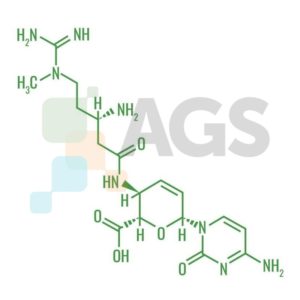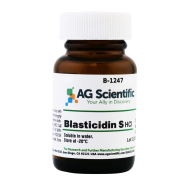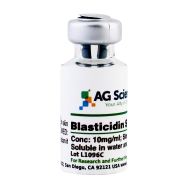Blasticidin S is an antibiotic used by scientists in bio-research to select cells modified by genetic engineering. It inhibits the growth of a wide range of prokaryotic and eukaryotic cells by interfering with protein synthesis.

Blasticidin S allows the selection and maintenance of cells expressing the blasticidin-resistance gene. Blasticidin S is a peptidyl nucleoside antibiotic isolated from the culture broth of Streptomyces griseochromogenes. It specifically inhibits protein synthesis in both prokaryotes and eukaryotes through inhibition of peptide-bond formation in the ribosomal machinery. It is used to select transfected cells carrying bsr or BSD resistance genes.
What is the procedure for Blasticidin selection in E. coli? |
| For selection of Blasticidin-resistant E. coli, use low salt LB medium (10 g Tryptone, 5 g sodium chloride, 5 g yeast extract) containing 50-100 µg/mL Blasticidin. Optimize the Blasticidin concentration for the bacterial strain being utilized. If a lawn of bacteria forms instead of individual colonies, increase the Blasticidin concentration in the plates to 100 µg/mL. Note: The salt concentration of the medium must remain (<90mM). Failure to lower the salt content of your LB medium inhibits Blasticidin, and prevents selection unless a higher Blasticidin concentration is used. |
What is the procedure for Blasticidin selection in yeast? |
| The concentration of Blasticidin required for selection in yeast varies depending on the species, strain, and type of medium used. Use a range of 25-300 µg / mL Blasticidin for yeast selection. We recommend performing a kill curve for each species, strain and medium used to determine the appropriate Blasticidin concentration to use for selecting resistant cells. |
What is the procedure for Blasticidin selection in mammalian cells? |
| The Blasticidin concentration required for selection in mammalian cells varies depending on the cell line used. Use 2-10 µg / mL Blasticidin for mammalian selection. We recommend performing a kill curve for each species, strain and medium used to determine the appropriate Blasticidin concentration to use for selecting resistant cells. |
How do you determine Blasticidin sensitivity? |
| a.) Plate cells at approximately 25% confluency. Prepare a set of 6 plates. Allow cells to adhere overnight. b.) The next day, substitute culture medium with medium containing varying concentrations of Blasticidin ( e.g. 0,2,4,6,8,10 µg/mL Blasticidin) c.) Replenish the selective media every 3-4 days, and observe the percentage of surviving cells. d.) Determine the appropriate concentration of Blasticidin that kills the cells within 10-14 days after addition of the antibiotic. |
What are conditions of selection? |
| E. coli: E. coli is poorly sensitive to Blasticidin S, but transformants resistant to Blasticidin S can be selected on low salt LB agar medium, pH8, supplemented with 100 µg/ml Blasticidin S. High pH enhances activity of Blasticidin S. Mammalian cells: the working concentration of Blasticidin S for mammalian cell lines varies from 1 to 50µg / ml. In a starting experiment we recommend to determine optimal concentrations of antibiotic required to kill your host cell line. After treatment, cell death occurs rapidly, as fast as G418 selection, allowing the selection of transfected cells with plasmids carrying the bsror BSD genes in as little as 7 days post-transfection. Suggested working conditions for selection in some mammalian cells are listed below. |

